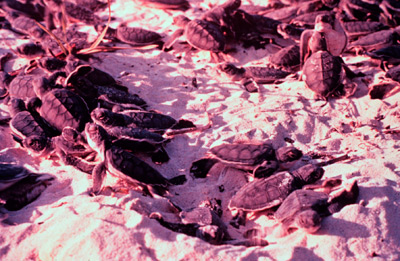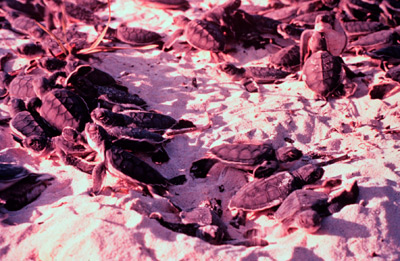 Our planet is an intriguing concoction of variables that meld together for successes spanning the organization of life (species, populations, communities, and ecosystems). It is literally an evolutionary process that is ecologically driven. And as a genotypic sex determined species, we seem to have an inherent fascination with the mysterious adaptive significance of environmental sex determination. But the evolution of environmental conditions, such as temperature, determining the sex of offspring is not what is going to be explored at this time. Nor do I plan to open up a heated discussion about climate change.
Our planet is an intriguing concoction of variables that meld together for successes spanning the organization of life (species, populations, communities, and ecosystems). It is literally an evolutionary process that is ecologically driven. And as a genotypic sex determined species, we seem to have an inherent fascination with the mysterious adaptive significance of environmental sex determination. But the evolution of environmental conditions, such as temperature, determining the sex of offspring is not what is going to be explored at this time. Nor do I plan to open up a heated discussion about climate change.
However, I am curious about the population dynamics of species exhibiting temperature-dependent sex determination in a warming world. More specifically, how will sea turtle populations fare if sex ratios are dramatically skewed as a result of warmer temperatures. Yet worry not as I am not alone in wondering about the stability of our threatened and endangered sea turtles.
Scientists from the Institute of Life Science, Institute of Environmental Sustainability and the National Marine Park of Zakynthos executed a study to determine if “temperature-dependent sex determination increases the probability of extirpation when ambient temperatures induce the production of offspring of a single sex.” Especially when, “Some taxonomic groups, such as sea turtles, are already endangered and have sex ratios skewed to the sex produced at warmer temperatures (females).”
However, measuring population viability is more than just determining the ratio of male and female hatchlings. Species stability requires a measurement of the number of males and females that are ready to mate at any one particular time (operational sex ratio), which also accounts for the breeding frequencies of each sex.
Results:
- Based on hatchling ratios, it is assumed that for every 100 adult turtles in the population, there were 70 females and 30 males.
- Males return to breed every year
- Females breed every 2.6 years
- Operational sex ratio is 47% female – in any particular year 30 out of 30 males will be breeding, but only 27 out of 70 females will breed.
 So just what does this data all mean? Well, the most striking finding is that since male sea turtles breed more frequently than females (i.e. an operational sex ratio that is not female biased), they are able to “reduce the probability of unfertilized clutches.” Even though males already comprise a smaller portion of the population, and would do so to a greater extent in a warming climate, the results are indicating that we (or they) do not have much to worry about when it comes to temperatures altering the sex ratios to a point where the population collapses. But perhaps this just might be limited to the SHORT-TERM.
So just what does this data all mean? Well, the most striking finding is that since male sea turtles breed more frequently than females (i.e. an operational sex ratio that is not female biased), they are able to “reduce the probability of unfertilized clutches.” Even though males already comprise a smaller portion of the population, and would do so to a greater extent in a warming climate, the results are indicating that we (or they) do not have much to worry about when it comes to temperatures altering the sex ratios to a point where the population collapses. But perhaps this just might be limited to the SHORT-TERM.
As pointed out by the authors, a male breeding cycle that is 2.6 times greater than females may help alleviate the impacts of climate change on the population, but there will undoubtedly be a reduction in males over time. And as males become limited the probability that a population will persist declines.
For example, it is predicted that under some climate-change scenarios, nesting beaches in some parts of the world will produce only female hatchlings. If this hatchling sex ratio propagates into adult sex ratios (e.g., there is no immigration of males from other sites), then the increased breeding frequency of males will be redundant because there will be no males.
Thus, we just may find ourselves taking on the role of the Earth’s climate by relying upon methods to control nest/embryonic temperatures in an attempt to artificially produce male hatchlings and ultimately prevent the loss of sea turtles.
![]()
HAYS, G., FOSSETTE, S., KATSELIDIS, K., SCHOFIELD, G., & GRAVENOR, M. (2010). Breeding Periodicity for Male Sea Turtles, Operational Sex Ratios, and Implications in the Face of Climate Change Conservation Biology DOI: 10.1111/j.1523-1739.2010.01531.x


Not something I’d thought about when worrying about global warming… but a scary possibility! A world without sea turtles due to single sex? 🙁
.-= Cristina´s last blog ..Hogueras y la Polvora a la Nit =-.
It all gets back to the interconnectedness of our planet…climate, plants, animals, etc. Reminds me of the following quote attributed to Jouhn Muir:
“When one tugs at a single thing in nature, he finds it attached to the rest of the world.”
[…] Thriving Oceans breaks down the theory behind how climate change may impact the breeding capability of sea turtles. […]
I have some great videos of Sea Turtles close up…
Sea Turtle Close up:
http://www.youtube.com/watch?v=A65eFS0w134
Sea Turtle Scares a lady:
http://www.youtube.com/watch?v=lNoqOdByIdk
enjoy,
.-= Chris´s last blog ..Crown Kings – Cover- Gin Blossoms – Hey Jealousy – Tempe Oktoberfest – Octoberfest =-.
Here is a couple more Great Videos of Sea Turtles:
Sea Turtle scares me while filming:
http://www.youtube.com/watch?v=sUllbKQ6sc0
Sea Turtles coming up for air:
http://www.youtube.com/watch?v=421Ci_yFraU
all filmed in Maui by Black Rock in Ka’anapali
I appreciate for the tips you parted.
I really do hope that they do not become left behind, I breed turtles and tortoise at home, I have not done many i have only just hatched 36 eggs, everyone lived, i then give them away to good homes. The pet shop ones are just done on a mass scale with no love for the actual animal, good post its hard sometimes to find the good sites from the bad but you done a good job here today, Even if you can get just one person to change this post has been worth it